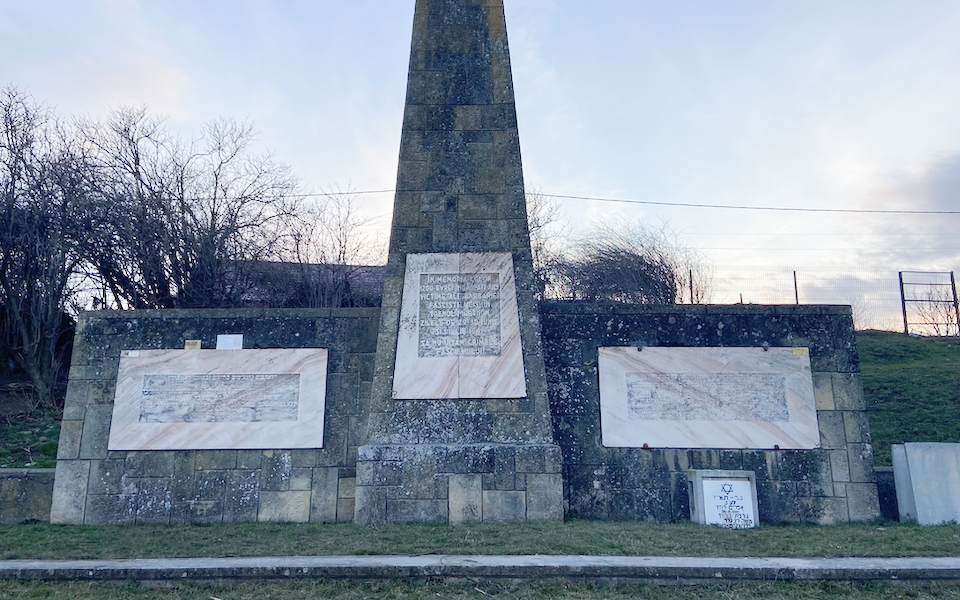Not far from the bright floral displays commemorating International Women’s Day and bustling souvenir stalls littering the main streets of Iasi, Romania, is the former Iași police headquarters. The old government building and its courtyard are calm, almost peaceful, but the site has a tragic history: On June 28, 1941 Romanian and German authorities, alongside Iasi residents, began murdering Iasi Jews in the streets and in their own homes. The next day, “Black Sunday,” these authorities rounded up thousands of Iasi Jews and shot them in the police headquarters courtyard. On the final day, they arrested and deported thousands more via “death trains,” which moved back and forth between stations until the occupants died from dehydration or suffocation. According to the U.S. Holocaust Memorial Museum, at least 8,000 Jews were murdered in Iasi.

The Iasi Pogrom Exhibit at the Police Headquarters courtyard in Iasi.
While in Romania for a work trip, I retraced the Eastern European country’s Nazi past with Father Patrick Desbois, the president of Yahad-In Unum and the author of Holocaust by Bullets, who has dedicated the past 20 years to identifying mass graves of Jewish victims of the Einsatzgruppen (Nazi “mobile killing units”). During the trip he brought us to the former Iași police headquarters, which is now the Iasi Pogrom Museum, and four mass graves. Three of these mass graves, with their large memorials and bronze plaques honoring the “victims of fascism,” were easily identifiable. The fourth one, however, an unmarked field, was nearly unidentifiable. According to witness testimonies, Romanian and German authorities stopped the “death train” at this field. When they opened the cattle cars to air them out and rid them of corpses, starved and dehydrated surviving passengers ran across the field to drink from nearby puddles. Those who did not collapse from the physical exertion died from the bacteria-infected water.
The legacy of these deaths continues in Romania—in January the Bucharest city council voted down a motion calling for the removal of a bust of Mircea Vulcanescu, a former finance minister during World War II whose antisemitic legislation facilitated the deaths of approximately 220,000 Romanian Jews. This legislation overtaxed Romanian Jews and confiscated their property.
Post-war communist authorities arrested Vulcanescu for collaborating with Nazi Germany and found him guilty in 1946. Since his death (in prison) in 1952, a mix of neo-Nazis, nationalists, historians and advocates for “the victims of communism” have come to his defense. These defenders’ arguments range from denying the former finance minister’s participation in the Romanian Jews’ persecution to critiquing the post-war communist trials’ legitimacy.
Among the defenders of the bust were Antonio Andrusceac, a parliament member of the Alliance for the Union of Romanians, a far-right party. Andrusceac applauded the Bucharest city council for protecting “the cult of its [Romania’s] heroes and martyrs.”
After they were expelled from the Kingdom of Hungary in 1367, Jews immigrated to Romania. From the 14th to 19th centuries local rulers highly encouraged Jewish immigrants to settle into the country and even drafted special charters for them, offering benefits such as tax exemption status and land for religious establishments. However, this changed when the Russian Empire took over the Moldavian and Wallachian regions in 1853. Antisemitism spread during this occupation, persisted during the Crimean War, and worsened after Romania gained independence in 1878.
Yet, throughout World War I and the interwar years, the Romanian Jewish population held its own. Romanian Jews founded a political party (the Jewish Party), a parliamentary club, and unions (the Union of Romanian Jews, the Union of Jewish Communities). They also bolstered the economy. Owning nearly 20 percent of the country’s industrial firms, they helped modernize glass, wood and furniture, and clothing and textile production. Prior to World War II, there were approximately 757,000 Jews in Romania. After World War II, the majority of Romanian Jews emigrated to Israel. Today there are only about 8,700 Jews in Romania.
The Romanian government has made attempts to confront its Nazi past. In 2003, former president Ion Iliescu established the Wiesel Commission, which was led by Romanian-born Jewish Nobel Laureate Elie Wiesel, to create a report on the history of Romania’s active involvement in the Holocaust. In 2005, Romania also established the Wiesel Institute for the Study of the Holocaust in Romania, a public institution dedicated to researching Romania’s role in the Holocaust, preserving victims’ and survivors’ oral histories and combating antisemitism through advocacy. The Wiesel Institute has championed the removal of monuments honoring Nazi perpetrators and collaborators. According to the Institute, the Bucharest city council’s motion to keep the Vulcanescu bust violates Romania’s Emergency Ordinance No. 31, which prohibits government officials from placing or maintaining “statues or commemorative plates related to persons guilty of crimes against humanity or peace” in public places (excluding museums), and the supplementary 2006 and 2015 laws.
Despite these laws, the bust of Vulcanescu continues to haunt the streets of Bucharest. It seems ironic that a vicious case of food poisoning prevented me from seeing the bust in person, as if even the thought of Vulcanescu and his Nazi legacy was enough to sicken me.
Top image: A stone monument to the Jews killed in the “Death Trains” at Podu Iloaiei, in Romania. Photo credit Jocelyn Flores

